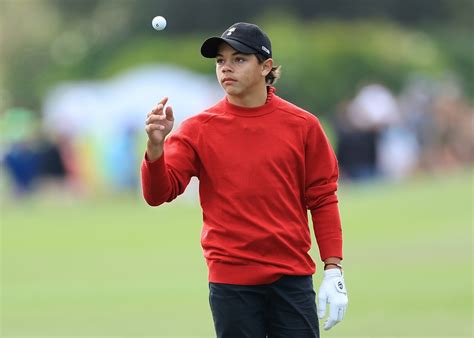
Charlie Woods concluded his amateur appearance at the Notah Begay III Junior Golf National Championship with a final-round 78, placing him in a tie for 26th overall, a performance that showcased both flashes of brilliance and the challenges of competitive golf.
Charlie Woods’ performance at the Notah Begay III Junior Golf National Championship, held at Koasati Pines at Coushatta Casino Resort in Kinder, Louisiana, concluded with a mix of promise and areas for improvement, as he finished tied for 26th after a final-round 78 (+6). Woods, son of golf icon Tiger Woods, entered the tournament amid considerable fanfare and high expectations, given his lineage and prior glimpses of golfing talent. While he demonstrated moments of exceptional play throughout the three-day event, consistency proved to be elusive, highlighting the demanding nature of competitive junior golf.
The younger Woods began the tournament with a solid, if unspectacular, round of 75 (+3), placing him in the middle of the pack. He showcased a steady game, marked by accurate tee shots and a reliable short game, elements often attributed to his father’s influence. The second round saw a marked improvement, with Woods carding a 71 (-1), reflecting better course management and improved putting. This performance elevated him in the standings and fueled anticipation for a strong finish. However, the final round presented a different set of challenges. Woods struggled to maintain the momentum he had established, encountering difficulties with both his tee shots and approach play. Several errant drives resulted in penalty strokes and difficult lies, forcing him to play defensively.
According to reports from on-site observers, the Koasati Pines course, known for its demanding layout and undulating greens, tested the young golfer’s ability to recover from setbacks. While Woods displayed resilience in certain stretches, he also succumbed to pressure, resulting in bogeys and double bogeys that ultimately inflated his score. “It was a learning experience for Charlie,” noted one tournament official who requested anonymity. “He showed flashes of brilliance, but consistency is key at this level. He’ll learn from this.”
Despite the final-round struggles, Woods’ participation in the tournament served as a valuable opportunity to gain experience in a high-pressure environment. He competed against some of the top junior golfers in the nation, providing a benchmark for his own development. The Notah Begay III Junior Golf National Championship, known for its competitive field and challenging courses, has become a proving ground for aspiring young golfers.
The tournament also highlighted the intense scrutiny that accompanies Charlie Woods due to his father’s legendary status. Every swing, every putt, and every score were closely monitored and analyzed, adding an extra layer of pressure on the young golfer. While Woods has demonstrated a remarkable ability to handle the spotlight, the expectations surrounding his career remain significant.
“He’s got a great future ahead of him,” said a parent of another participant. “He’s got the work ethic and the support system. It’s just a matter of time and experience.”
Looking ahead, Charlie Woods is expected to continue honing his skills and competing in junior golf tournaments. The experience gained at the Notah Begay III Junior Golf National Championship will undoubtedly serve as a valuable lesson as he progresses in his golfing journey. While the final result may not have met the highest expectations, the tournament provided a glimpse of his potential and the challenges he faces as he navigates the world of competitive golf.
In-Depth Analysis:
Charlie Woods’ performance at the Notah Begay III Junior Golf National Championship offers a nuanced perspective on his development as a golfer. It’s crucial to analyze his game beyond the final leaderboard position to understand the areas where he excels and the aspects that require further refinement.
Strengths:
One of Woods’ clear strengths is his ball-striking ability. He consistently demonstrates a smooth and powerful swing, generating impressive distance off the tee. His iron play is also noteworthy, with accurate approaches to the greens, allowing him to create scoring opportunities. These technical skills reflect the influence of his father, Tiger Woods, who is renowned for his precision and power. Moreover, Charlie has shown remarkable composure on the course, especially given his age and the intense media attention surrounding him. He carries himself with a maturity that belies his years, handling pressure situations with grace and focus.
Areas for Improvement:
Despite his strengths, Charlie Woods’ game also reveals areas that need improvement. Consistency remains a key challenge. While he is capable of producing brilliant shots and low scores, he also experiences periods of inconsistency, particularly with his tee shots. Erratic drives can lead to penalty strokes and difficult lies, disrupting his momentum. Another area for development is his short game, specifically his putting. While he has shown improvement in this area, his ability to consistently convert birdie opportunities needs to be refined. Furthermore, course management is another aspect where he can enhance his skills. Making better decisions regarding club selection and strategy can help him avoid unnecessary risks and minimize mistakes.
Mental Game:
The mental aspect of golf plays a crucial role in success, and Charlie Woods is no exception. His ability to handle pressure and maintain focus is commendable, but there is always room for improvement. Developing mental resilience and learning to bounce back from setbacks are essential skills for any competitive golfer. Working with a sports psychologist or mental coach could provide him with valuable tools and strategies to enhance his mental game.
Comparison to Tiger Woods at the Same Age:
Comparisons between Charlie Woods and his father, Tiger Woods, are inevitable, but it’s important to approach these comparisons with caution. Tiger Woods was a phenom in his junior golf days, achieving remarkable success at a young age. While Charlie Woods has shown flashes of brilliance, he is still developing his game and finding his own path. It’s unfair to expect him to replicate his father’s achievements at the same age. Instead, it’s more appropriate to focus on his individual progress and potential. Charlie has the talent, work ethic, and support system to achieve great things in golf, but he needs time and space to develop at his own pace.
The Role of Coaching and Training:
The quality of coaching and training plays a significant role in a golfer’s development. Charlie Woods has access to world-class coaching and training resources, thanks to his father’s expertise and connections. However, it’s important to find the right balance between guidance and independence. Charlie needs to develop his own unique style and approach to the game, rather than simply mimicking his father. A good coach can provide technical instruction, strategic advice, and mental support, while also allowing the golfer to express their individuality.
The Impact of Media Attention:
The intense media attention surrounding Charlie Woods can be both a blessing and a curse. On the one hand, it provides him with valuable exposure and opportunities. On the other hand, it can create undue pressure and distraction. Learning to manage the media spotlight and maintain focus on his game is a crucial challenge. Surrounding himself with a supportive team and establishing clear boundaries can help him navigate the media landscape effectively.
Future Prospects:
Despite the challenges, Charlie Woods has a bright future in golf. He possesses the talent, work ethic, and support system to achieve success at the highest levels. As he continues to develop his game and gain experience, he has the potential to become a top player in the world. However, it’s important to manage expectations and allow him to progress at his own pace. The journey of a golfer is a marathon, not a sprint, and Charlie Woods has the potential to achieve great things over the long term. His performance at the Notah Begay III Junior Golf National Championship serves as a valuable learning experience, providing insights into his strengths, weaknesses, and areas for improvement. As he continues to hone his skills and refine his game, he is well-positioned to achieve his goals and make a name for himself in the world of golf.
Expanding on the Tournament Details:
The Notah Begay III Junior Golf National Championship is a prestigious event that provides a platform for top junior golfers from across the United States to showcase their talent. Named after Notah Begay III, a Native American professional golfer, the tournament aims to promote opportunities for young golfers from diverse backgrounds. The event attracts a highly competitive field, with participants vying for national recognition and college scholarship opportunities.
The Koasati Pines at Coushatta Casino Resort, the venue for the championship, is a challenging course that tests the skills of even the most accomplished golfers. The course features undulating greens, strategically placed bunkers, and water hazards that demand precision and strategic thinking. The conditions can vary significantly, depending on the weather, adding another layer of complexity to the competition. Players must adapt to different wind conditions, temperatures, and course conditions, demonstrating their versatility and adaptability.
The tournament format consists of three rounds of stroke play, with the lowest score determining the champion. The competition is intense, with players battling for every stroke. The pressure to perform can be significant, especially in the final round, when the stakes are highest. The Notah Begay III Junior Golf National Championship provides a valuable experience for young golfers, preparing them for the challenges of college and professional golf. It’s an opportunity to compete against the best, learn from their peers, and gain exposure to college coaches and recruiters.
The Woods Family Legacy and its Impact:
The Woods family legacy looms large over Charlie Woods’ career. His father, Tiger Woods, is one of the most iconic figures in the history of golf, having achieved unprecedented success and revolutionizing the game. The weight of this legacy can be both a blessing and a burden for Charlie. On the one hand, he has access to invaluable knowledge, resources, and support. On the other hand, he faces immense pressure to live up to his father’s achievements.
Tiger Woods has played an active role in his son’s development, providing guidance, coaching, and encouragement. He has shared his expertise and insights, helping Charlie to hone his skills and develop his game. However, he has also been careful to avoid imposing his own expectations on his son. He has emphasized the importance of enjoying the game and developing a love for golf, rather than simply focusing on results.
The relationship between father and son is a unique dynamic, filled with both admiration and pressure. Charlie Woods has expressed his gratitude for his father’s support and guidance, but he has also emphasized his desire to forge his own path. He wants to be known for his own accomplishments, rather than simply being defined as Tiger Woods’ son.
The Woods family legacy has undoubtedly shaped Charlie’s career, but it is ultimately up to him to determine his own destiny. He has the talent, work ethic, and support system to achieve great things in golf, but he must also find his own identity and embrace his own unique journey.
The Future of Junior Golf:
Junior golf is a rapidly growing and evolving landscape, with increasing participation and competition. The Notah Begay III Junior Golf National Championship is a prime example of the rising talent and dedication among young golfers. The event showcases the depth of talent in the junior ranks and provides a glimpse into the future of the sport.
Technological advancements have played a significant role in the evolution of junior golf. Launch monitors, swing analysis software, and online training resources have become increasingly accessible, allowing young golfers to track their progress and improve their skills. Coaching methods have also evolved, with a greater emphasis on biomechanics, mental training, and individualized instruction.
The rise of social media has also had a profound impact on junior golf. Young golfers can now connect with coaches, peers, and fans from around the world, sharing their experiences and building their brands. Social media platforms have become valuable tools for showcasing talent, attracting sponsorships, and gaining exposure.
The future of junior golf is bright, with increasing opportunities for young golfers to develop their skills and pursue their dreams. Tournaments like the Notah Begay III Junior Golf National Championship provide a valuable platform for these young athletes to showcase their talents and gain recognition. As junior golf continues to evolve, it is essential to provide support and resources to help young golfers reach their full potential.
The Impact of the Performance on Future Expectations:
Charlie Woods’ performance at the Notah Begay III Junior Golf National Championship will inevitably shape expectations for his future endeavors. While the final result may not have been as impressive as some had hoped, it’s important to consider the context and circumstances. He is still a young and developing golfer, and setbacks are a natural part of the learning process.
The key takeaway from the tournament is not the final score, but rather the lessons learned and the experiences gained. Charlie Woods had the opportunity to compete against some of the best junior golfers in the nation, test his skills on a challenging course, and handle the pressure of a high-stakes competition. These experiences will undoubtedly serve him well as he continues his golfing journey.
Moving forward, it’s important to manage expectations and avoid placing undue pressure on Charlie Woods. He should be allowed to develop at his own pace and focus on improving his game without the burden of unrealistic expectations. The support of his family, coaches, and peers will be crucial in helping him navigate the challenges ahead.
Charlie Woods has the potential to achieve great things in golf, but it’s important to remember that success is not guaranteed. He must continue to work hard, stay focused, and embrace the journey. His performance at the Notah Begay III Junior Golf National Championship is just one chapter in his golfing story, and the best is yet to come.
Frequently Asked Questions (FAQ):
1. What was Charlie Woods’ final score and overall placement at the Notah Begay III Junior Golf National Championship?
Charlie Woods finished tied for 26th place at the Notah Begay III Junior Golf National Championship with a final-round score of 78 (+6). His overall score for the tournament was +5.
2. Where did the Notah Begay III Junior Golf National Championship take place?
The tournament was held at Koasati Pines at Coushatta Casino Resort in Kinder, Louisiana.
3. What were Charlie Woods’ scores in each of the three rounds of the tournament?
Charlie Woods scored 75 (+3) in the first round, 71 (-1) in the second round, and 78 (+6) in the third and final round.
4. How does Charlie Woods’ performance compare to his father, Tiger Woods, at a similar age?
Comparisons should be made with caution, as Tiger Woods was a phenom in junior golf. While Charlie has shown talent, he is developing at his own pace, and it’s unfair to directly compare his achievements at the same age.
5. What are the key areas Charlie Woods needs to improve to enhance his golf game?
Based on analysis of his performance, key areas for improvement include consistency off the tee, short game, particularly putting, and course management. Continued development of his mental game will also be crucial.
Elaborating on Charlie Woods’ Round-by-Round Performance:
The nuances of each round in the Notah Begay III Junior Golf National Championship offer deeper insights into Charlie Woods’ strengths and challenges during the tournament.
Round 1: A Steady Start
Woods began the tournament with a 75 (+3), a round characterized by steady play but lacking the spark needed to contend for the lead early. His tee shots were generally accurate, placing him in favorable positions on the fairways. His iron play was also solid, allowing him to approach the greens with precision. However, his putting was inconsistent, resulting in several missed birdie opportunities. This round reflected a conservative approach, prioritizing accuracy and avoiding major mistakes, which is understandable given the pressure and heightened scrutiny surrounding his participation. This approach positioned him respectably within the field, providing a foundation to build upon in subsequent rounds.
Round 2: A Glimmer of Excellence
The second round saw a significant improvement, with Woods carding a 71 (-1). This performance demonstrated his potential and ability to compete at a high level. His tee shots were longer and more accurate, allowing him to take advantage of scoring opportunities on the par-5 holes. His iron play remained consistent, and his putting improved considerably, resulting in several birdies. This round showcased his confidence and aggression, suggesting he was more comfortable with the course and the competitive environment. His improved score reflected better decision-making and execution, highlighting his capacity for growth and adjustment.
Round 3: Challenges and Setbacks
The final round presented significant challenges, with Woods carding a 78 (+6). This round revealed some of the weaknesses in his game and the areas where he needs to improve. His tee shots were erratic, resulting in penalty strokes and difficult lies. His iron play was less precise, and his putting faltered under pressure. Despite these setbacks, he showed resilience in certain stretches, battling back from adversity and displaying mental fortitude. However, the cumulative effect of the errors proved too much to overcome, resulting in a higher score. This round served as a valuable learning experience, highlighting the importance of consistency and the ability to manage pressure in high-stakes situations.
The Psychological Aspect of Junior Golf Competitions:
Competing in junior golf tournaments like the Notah Begay III Junior Golf National Championship presents unique psychological challenges for young athletes. The pressure to perform, the expectations of parents and coaches, and the intense competition can create significant stress. Developing mental resilience and coping mechanisms is crucial for success.
Managing Expectations:
One of the biggest challenges is managing expectations. Young golfers often feel pressure to meet the expectations of their parents, coaches, and themselves. Setting realistic goals and focusing on the process, rather than solely on the outcome, can help alleviate this pressure.
Dealing with Setbacks:
Setbacks are inevitable in golf. Every golfer, regardless of their skill level, experiences bad shots, missed putts, and disappointing rounds. Learning to cope with setbacks and bounce back from adversity is an essential skill. Developing a positive attitude and focusing on the next shot can help young golfers overcome these challenges.
Maintaining Focus:
Maintaining focus throughout a round of golf can be difficult, especially in a competitive environment. Distractions, fatigue, and negative thoughts can all derail a golfer’s concentration. Developing mental strategies, such as visualization and positive self-talk, can help maintain focus and improve performance.
Building Confidence:
Confidence is essential for success in golf. Believing in one’s abilities and trusting one’s swing can make a significant difference in performance. Setting small, achievable goals and celebrating successes can help build confidence and create a positive mindset.
Seeking Support:
Seeking support from coaches, parents, and peers can be invaluable in managing the psychological challenges of junior golf. Talking about anxieties, fears, and frustrations can help alleviate stress and provide a sense of perspective. A sports psychologist or mental coach can also provide valuable tools and strategies for improving mental performance.
The Notah Begay III Foundation and its Mission:
The Notah Begay III Foundation is a non-profit organization dedicated to improving the health and wellness of Native American youth. Founded by Notah Begay III, the foundation provides resources and support for programs that promote healthy lifestyles, educational opportunities, and cultural preservation.
The foundation’s mission is to empower Native American youth to achieve their full potential by providing access to health and wellness programs, educational opportunities, and cultural resources. The foundation supports a variety of initiatives, including:
Youth Golf Programs: The foundation provides funding and support for golf programs that introduce Native American youth to the game of golf and promote healthy lifestyles. Educational Scholarships: The foundation awards scholarships to Native American students pursuing higher education. Health and Wellness Initiatives: The foundation supports programs that address health disparities in Native American communities, such as diabetes prevention and childhood obesity. Cultural Preservation Programs: The foundation supports programs that promote the preservation and celebration of Native American culture.
The Notah Begay III Junior Golf National Championship is a key fundraising event for the foundation. Proceeds from the tournament support the foundation’s programs and initiatives. The tournament provides a platform for young golfers from diverse backgrounds to showcase their talent and compete for national recognition.
The Notah Begay III Foundation plays a vital role in supporting Native American youth and promoting health and wellness in their communities. The foundation’s commitment to education, cultural preservation, and healthy lifestyles is making a positive impact on the lives of countless young people.
Analyzing the Course Conditions at Koasati Pines:
The Koasati Pines at Coushatta Casino Resort presented a significant challenge to the participants in the Notah Begay III Junior Golf National Championship. The course is known for its undulating greens, strategically placed bunkers, and water hazards that demand precision and strategic thinking.
Greens: The greens at Koasati Pines are notoriously difficult to read and navigate. Their undulations and subtle breaks make putting a challenge, even for experienced golfers. The speed of the greens can also vary depending on the weather, adding another layer of complexity.
Bunkers: The course features numerous strategically placed bunkers that punish errant shots. The bunkers are deep and challenging to escape from, requiring precision and skill.
Water Hazards: Water hazards come into play on several holes, demanding accuracy and strategic decision-making. Avoiding water hazards is crucial for maintaining a good score.
Fairways: The fairways at Koasati Pines are generally well-maintained, but they can be narrow in certain areas, requiring accuracy off the tee.
Wind: Wind can be a significant factor at Koasati Pines, affecting ball flight and making club selection challenging.
The course conditions at Koasati Pines tested the skills of all the participants in the Notah Begay III Junior Golf National Championship. The challenging layout and demanding conditions required precision, strategic thinking, and mental fortitude.
The Role of Junior Golf Associations:
Junior golf associations play a crucial role in the development of young golfers. These organizations provide opportunities for young players to compete, learn, and grow in a supportive and structured environment.
Tournaments: Junior golf associations organize tournaments at various levels, providing opportunities for young golfers to test their skills and compete against their peers. These tournaments often offer valuable ranking points and exposure to college coaches and recruiters.
Instruction: Many junior golf associations offer instructional programs, providing young golfers with access to quality coaching and training. These programs can help young players develop their skills, improve their technique, and learn the fundamentals of the game.
Rules and Etiquette: Junior golf associations teach young players the rules and etiquette of the game, instilling in them a sense of sportsmanship and respect for the game.
Scholarships: Some junior golf associations offer scholarships to help young golfers pursue higher education. These scholarships can provide valuable financial assistance to deserving students.
Mentorship: Junior golf associations often provide mentorship opportunities, pairing young golfers with experienced players and coaches who can provide guidance and support.
Junior golf associations are essential for the development of young golfers. These organizations provide opportunities for young players to compete, learn, and grow in a supportive and structured environment, helping them reach their full potential.
The Importance of Parental Support in Junior Golf:
Parental support plays a vital role in the success of young golfers. Parents can provide encouragement, guidance, and resources to help their children develop their skills and pursue their dreams.
Encouragement: Parents can provide encouragement and support, helping their children to stay motivated and positive, even when facing challenges.
Guidance: Parents can provide guidance and advice, helping their children to make informed decisions about their training, competition schedule, and career goals.
Resources: Parents can provide resources, such as equipment, coaching, and travel expenses, to help their children develop their skills and compete at a high level.
Emotional Support: Parents can provide emotional support, helping their children to cope with the pressures of competition and the challenges of pursuing a demanding sport.
Balance: It’s important for parents to strike a balance between support and pressure. While encouragement and guidance are important, it’s also essential to allow children to develop their own passions and pursue their goals at their own pace.
Parental support is crucial for the success of young golfers. Parents can provide encouragement, guidance, and resources to help their children develop their skills and pursue their dreams, while also fostering a love for the game and a healthy balance in their lives.









